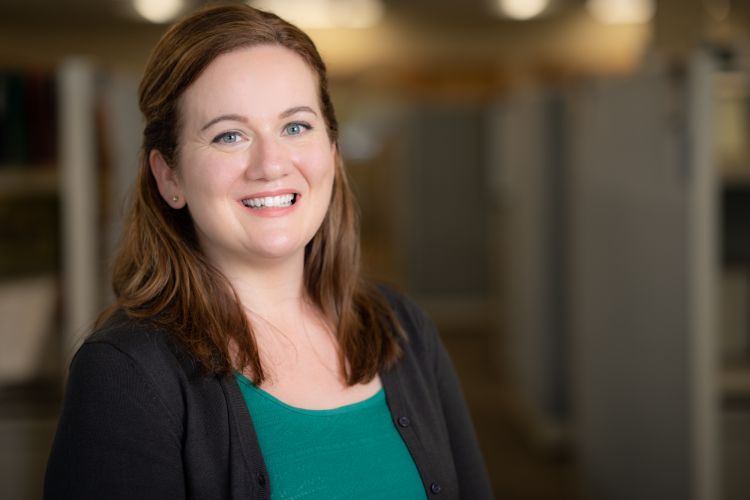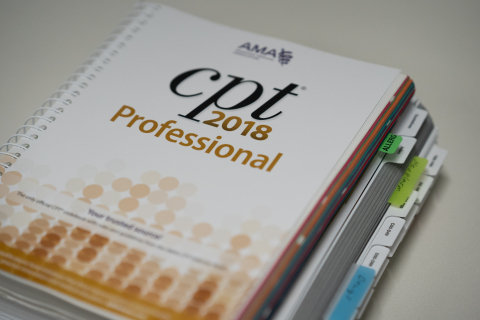Everyday remarkable: behind the scenes with medical coder Amanda Wemmer

As an English major, Amanda Wemmer performed literary analysis on written works, looking closely at elements such as plot and characters to see how they affect the whole. As a medical coding professional, Wemmer does something quite similar: she looks closely at records of medical procedures, breaking down the story of an individual’s health care into discrete components.
“We take the provider’s documentation and turn the words into alphanumeric codes, which can be turned back into words, to allow payers and researchers to keep track of what was done,” said Wemmer.
It’s a process that is intricate, detail-oriented, and ever-changing. Not only does the practice of medicine change due to advances in clinical care, but the code sets themselves evolve over time as new editions are released.
The behind-the-scenes work of medical coding is absolutely essential to the functionality of any healthcare organization. Physicians may add placeholder codes into medical records, but they rely on professional coders fluent in the nuances of coding to finalize each record with accuracy and fidelity. For Wemmer, the endeavor is also personally fulfilling. “I feel really good about the fact that I'm making sure that our providers get credit for what they are doing, and that patients are being billed fairly,” she said.
Medical coding relies on defined lexicons: the American Medical Association’s Current Procedural Terminology (AMA CPT) and the World Health Organization’s International Statistical Classification of Diseases (ICD). The AMA CPT is updated each year on January 1, and the ICD is updated annually in October. “We work with around 70,000 different codes,” said Wemmer.
To be effective, professional medical coders are continually learning. They must understand not only the complexities of various medical specialties, but also gain fluency in new editions of the CPT and ICD. “This is a job that combines a lot of research, and also the communications skills that I did pick up as an English major are directly applicable,” said Wemmer.
For coders who have been in the field for numerous years, even the workplace location itself has changed. Implementation of electronic health record (EHR) systems was revolutionary. “Before the EHR we had to go to the hospital, find the patient's charts by the room, and sit on the floor trying to code as quickly and unobtrusively as possible,” said Wemmer. Today, many medical coding professionals work remotely, which makes it a very family-friendly career option.
“It is a very solitary activity when you're actually coding, and working from home can allow you to have the level of quiet that and lack of interruption that is needed. The flexibility is an attractive part of the job,” said Wemmer.
 Another sea change was the recent adoption of the ICD-10-CM* standard, which shifted from a solely numeric system to an alphanumeric system, enabling much more specificity. “ICD-10 is more useful for research purposes than ICD-9 was. Anyone who is data-mining can get a lot more granular about what was done,” explained Wemmer.
Another sea change was the recent adoption of the ICD-10-CM* standard, which shifted from a solely numeric system to an alphanumeric system, enabling much more specificity. “ICD-10 is more useful for research purposes than ICD-9 was. Anyone who is data-mining can get a lot more granular about what was done,” explained Wemmer.
Just as clinicians develop expertise in certain medical specialties, so do medical coding professionals. Specialty coders work within a specific section such as cardiovascular medicine, nephrology, or rheumatology. “Coders working in a section get very, very good - expert - at coding procedures in that area,” said Wemmer. She herself started in pulmonary and critical care medicine, then shifted to float work which required expanding her expertise to other specialties. “As a float coder, I was cross-trained in all areas of the Department of Medicine. My job was to fill in for vacations and cover sick leave. I really like learning new things and getting to change things up a lot. This is a profession that involves lifelong learning,” she said.
Wemmer has facilitated the learning process for many new medical coding professionals, as well. She has recruited several people into the field, serves as a mentor to apprentice coders, and welcomes students to observe her during job shadowing experiences. The stages of medical coding education mirror the “see, do, teach” phases of clinical medical education. “When we hire a new coder, usually I take some time and sit with them for a few weeks to months. First they watch me code, and then I review everything they do before we send them off on their own,” explained Wemmer.
Entering the field requires completing a one-year or two-year degree program that covers human anatomy, medical terminology, and the theory and practice of coding, plus occupational training such as the UW Health coding apprenticeship program, followed by certification.“It's a field that has a lot of different possible applications,” said Wemmer. “There are coders who travel and do presentations and education, coders that do audits for the government, and coders who are lawyers and who work on healthcare reform.”
Despite all of the shifts within the profession over her past twelve years as a coder, one thing has stayed constant in Wemmer’s personal life: she remains an avid book lover. “Even though I read all day for my job I still love to read. All genres, including the classics,” she said.
* Footnote: ICD-10-CM the United States' clinical modification of the World Health Organization’s ICD-10 and is implemented by the WHO Collaborating Center for the Family of International Classifications in North America, housed at the Centers for Disease Control and Prevention's National Center for Health Statistics (NCHS).
Editor’s note: This is the second article in our Everyday Remarkable series, which tells the stories of staff members within the Department of Medicine. Nearly 350 staff members on our team are dedicated to educating the next generation of physicians, advancing health, facilitating and conducting life-changing research, and ensuring the smooth operation of the largest academic department in the UW System. We’ll go behind the scenes with staff to give Vital Signs readers a glimpse into the roles, responsibilities, challenges, and joys that they encounter every day. Have a suggestion for a person or job that you think we should cover? Contact us.
Resources:
- "Everyday remarkable - behind the scenes with fellowship coordinator Molinda Henry," Department of Medicine, May 3, 2018
- "Everyday remarkable: behind the scenes with scientist Jianhua Zhang, PhD," Department of Medicine, July 12, 2018